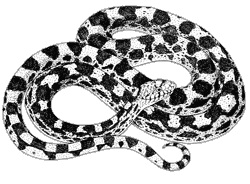Gophersnake
(Pituophis catenifer)
Order: Squamata
Family: Colubridae (colubrid snakes)
Spanish names: víbora sorda
Distinguishing Features
Large and heavy-bodied, the gophersnake is reported to reach 9 feet (275 cm) in length, but 4 feet (120 cm) is more common. On its back are 33 to 66 light- to dark-brown or reddish blotches on a ground color of yellow, straw, tan or cream. Smaller blotches are located on the animals sides. A dark stripe runs from in front of the eye to the angle of the jaw. The underside is creamy or yellow, often with dark spots. The scales on the back are strongly keeled, becoming smoother on the sides.

Range
This is one of the most widespread snakes in North America. Its range extends from the Atlantic to Pacific oceans, as far north as southern Canada, and as far south as Veracruz and southern Sinaloa, Mexico, including Baja California.
Habitat
A habitat generalist, the gophersnake is found in deserts, prairies, woodlands, brushlands, coniferous forests, and even cultivated lands. These biomes can be rocky, sandy, sparsely or heavily vegetated, and range from below sea level to over 9000 feet (2700 m).
Life History
When disturbed, the gophersnake will rise to a striking position, flatten its head into a triangular shape, hiss loudly and shake its tail at the intruder. These defensive behaviors, along with its body markings, frequently cause the gophersnake to be mistaken for a rattlesnake. The tapered tail, the absence of a rattle, the lack of a facial pit, and the round pupils all distinguish the gophersnake from the rattlesnake. The gophersnake is active mainly during the day, except in extreme heat when it ventures out at night. It is a good climber. A constrictor, it consumes mostly mammals, although birds and their eggs are also eaten. During the summer 2 to 24 eggs are laid which hatch in the fall.
Male gophersnakes engage in ritualistic combats during the spring mating season. The combatants remain on the ground, entwined from tail to neck. Each tries to maintain its head and body position, although occasionally they will exert so much force that they roll. Hissing frequently, they rarely bite one another. Presumably the combat ritual is a means of determining the sexual fitness of a male, for usually only the victor will copulate afterward.